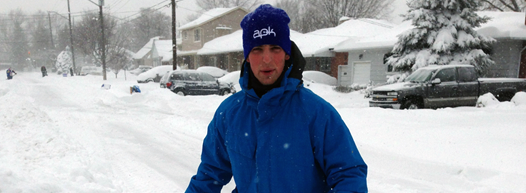Winter training: a guide to cold-weather parkour training
It’s getting to be that time of year again, the time of year where most traceurs go into hibernation due to the winter months.
The lucky traceurs who live in California, Texas, Florida, or other relatively warm areas don’t have to worry about cold temperatures, or snow, inhibiting their training. Unfortunately, I am not one of those lucky traceurs. Here in Canada, I’ve had to deal with the cold since I’ve started training.
During that time, I’ve heard a variety of opinions on whether you should still train outdoors in the winter. Some suggest that you shouldn’t train outdoors in the winter at all because of the dangers of slipping on ice. Others advocate this kind of training, as it provides yet another opportunity to adapt to the environment. Personally, I’ve found it super important to train throughout the winter, despite other’s hesitations.
In this article, I’d like to explain why I feel winter training is important, and then I’d like to provide a few tips to help you train safely.
The importance of winter training
One of the reasons I believe winter training is extremely important relates to the definition of parkour. In recent years, and even further back, the definition of parkour has been debated. However, most practitioners agree that parkour is an outdoor activity, or at least that the main intent is to be able to train on surfaces that mimic what is found outdoors or in our daily lives (as opposed to springy, cushioned gym environments).
With that in consideration, alongside my experience working in a gymnastics gym, I feel as if something is taken away from your training when you limit yourself to these cushiony environments, away from the cold. Your understanding of what you are able to do outdoors becomes skewed from holing yourself up in a gym for a number of months. This may lead to potential injuries when you start training outdoors again in the spring.
Speaking of injuries, traceurs who oppose outdoor training year-round will often suggest that winter training is dangerous due to an increased chance of slipping. Realistically, it’s not that different from when a person starts parkour . They traverse the environment for the first time; they learn the limits of what they can and cannot do safely.
Most people find that by evaluating a winter environment from this beginner’s mindset, and building on it progressively, much of the danger will be eliminated.

Tips for the best winter training experiences
At the end of the day, the decision to train outdoors in the winter is completely up to you. Personally, I feel like it is beneficial and for those of you willing to give the cold a shot I’ve decided to list a few tips that I often put into practice:
- Double Up! There’s a fine line between wearing clothes warm enough to train in, and still having the mobility that you want. Often what I do is I’ll just wear two of everything. This includes two pairs of sweatpants, two t-shirts, two (light) sweaters, etc.
- Earmuffs vs. Tuques. This one is a personal preference, but I tend to like earmuffs (the ones that go behind your head) better than tuques because I sweat more in a tuque than I do in muffs. Sweat and cold weather can chill a person rather quickly, causing a pretty quick end to any training session.
- Choose your gloves wisely. My gloves of choice are always the fingerless ones that have the flip-over tops. This way I can keep them fingerless when I’m training, so I can still feel my environment, but between runs I can flip the knitted tops over the fingers and turn them into mittens for extra warmth.
- Watch your step by turning it into a game. Try not to get your shoes wet right away by stepping in snow. This gives you a bit of familiarity with how your shoes will react. This is a double tip because it then turns into a game of “Don’t Touch The Snow.” Using the snow banks as natural obstacles adds an extra element to your training, since you can create new stride and precision lines using the dry patches where there is no snow. This can be super refreshing, since it spruces up the possibilities at a spot that you’ve trained at numerous times before.
- Use snow wisely—not all of it is ‘fluffy’. Speaking of using the snow to your advantage, many traceurs will be tempted to use big fluffy snow banks as crash mats for flips. However, some banks are unsafe because snow can melt quickly and refreeze as chunks of ice, which fluffier snow can then accumulate on. The end result is essentially a big chunk of solid ice disguised as a fluffy crash mat… not something you necessarily want to jump into, meaning you should inspect the snow bank before busting out that brand new triple gainer!
Community Tips
- Raul Piscoya, from Pleasanton, CA, reminds traceurs to spend a little extra time warming up. Instead of a normal 10 minute warmup, aim for 30 minutes.
Final notes
Overall, the winter can be a solid time of year for improving your fluidity, learning to look at your environment in different ways, and simply changing the way you train to surpass your most recent plateau.
Have fun training, stay warm and as usual, be safe!
